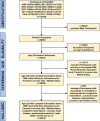Association between the female hormone intake and cardiovascular disease in the women: a study based on NHANES 1999-2020
- PMID: 39719571
- PMCID: PMC11667859
- DOI: 10.1186/s12889-024-21001-x
Association between the female hormone intake and cardiovascular disease in the women: a study based on NHANES 1999-2020
Abstract
Although many studies have reported the relationship between female hormone intake and cardiovascular disease (CVD) development, their association has not been fully elucidated and defined, based on data from the Third National Health and Nutrition Examination Survey intending to assess the health and nutritional status of non-institutionalized children and adults in the United States. This study examined the relationship between female hormone intake and coronary artery disease (CVD) development in 38,745 women, averaging 38.10 ± 12.59 years in age. We explored the association between hormone intake and CVD incidence, considering various social determinants of health (SDOH) with statistical methods like Chi-square tests, logistic regression, and stratified Chi-square analysis. Our findings reveal a complex relationship between female hormone intake and CVD development. Hormones appear to reduce CVD risk in women over 60 years old. However, hormone intake correlates with increased CVD risk in highly educated women. Socioeconomic status also influences this relationship; while hormones pose a risk factor for heart failure and stroke in impoverished or wealthy women, they serve as a protective factor against CVD for middle-income women. Additionally, hormonal intake seems beneficial for women who experienced menarche between 13 and 15 years old, menopause between 30 and 49, and had 7-9 pregnancies, especially when coupled with a diet low in sugar, fat, cholesterol, and adequate folic acid intake. These results indicate that while hormones can prevent CVD under specific conditions, their impact can be detrimental in different SDOH contexts. In conclusion, while appropriate hormone intake can prevent CVD, its effects vary across different demographic and health backgrounds. This underscores the necessity for meticulous screening of SDOH factors in clinical settings to maximize the protective benefits of hormones against CVD.
Keywords: Cardiovascular disease; Female hormone intake; NHANES; SDOH factor.
© 2024. The Author(s).
Conflict of interest statement
Declarations. Ethics approval and consent to participate: This research analyzed de-identifed information downloaded from the National Health and Nutrition Examination Survey public database. The National Center for Health Statistics Ethics Review Committee granted ethics approval. All methods were carried out in accordance with relevant guidelines and regulations (declaration of Helsinki). All individuals provided written informed consent before participating in the study. Consent for publication: Not applicable. Competing interests: The authors declare no competing interests.
Figures


Similar articles
-
Dietary intake of folate and risk of stroke in US men and women: NHANES I Epidemiologic Follow-up Study. National Health and Nutrition Examination Survey.Stroke. 2002 May;33(5):1183-8. doi: 10.1161/01.str.0000014607.90464.88. Stroke. 2002. PMID: 11988588
-
Lone mothers are at higher risk for cardiovascular disease compared with partnered mothers. Data from the National Health and Nutrition Examination Survey III (NHANES III).Health Care Women Int. 2005 Aug;26(7):604-21. doi: 10.1080/07399330591004845. Health Care Women Int. 2005. PMID: 16126603
-
Associations of healthy lifestyle and socioeconomic status with mortality and incident cardiovascular disease: two prospective cohort studies.BMJ. 2021 Apr 14;373:n604. doi: 10.1136/bmj.n604. BMJ. 2021. PMID: 33853828 Free PMC article.
-
Social Determinants of Health and Cardiovascular Disease: Current State and Future Directions Towards Healthcare Equity.Curr Atheroscler Rep. 2021 Jul 26;23(9):55. doi: 10.1007/s11883-021-00949-w. Curr Atheroscler Rep. 2021. PMID: 34308497 Review.
-
Cardiovascular disease in women and noncontraceptive use of hormones: a feminist analysis.ANS Adv Nurs Sci. 1992 Jun;14(4):34-49. doi: 10.1097/00012272-199206000-00006. ANS Adv Nurs Sci. 1992. PMID: 1605587 Review.
References
-
- Virani SS, Newby LK, Arnold SV, et al. 2023 AHA/ACC/ACCP/ASPC/NLA/PCNA Guideline for the Management of Patients With Chronic Coronary Disease: a report of the American Heart Association/American College of Cardiology Joint Committee on Clinical Practice Guidelines. J Am Coll Cardiol. 2023;82(5):833–955. - PubMed
-
- Mensah GA, Fuster V, Roth GA. A heart-healthy and stroke-free world: using data to inform global action. J Am Coll Cardiol. 2023;82(6):2343–9. - PubMed
MeSH terms
Grants and funding
LinkOut - more resources
Full Text Sources

